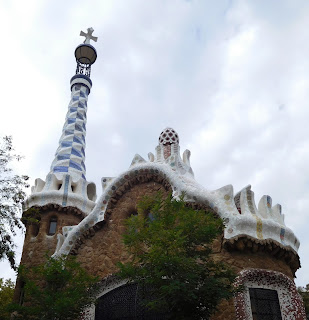The stunning La Sagrada Familia since 1882 is still "under construction", however it is not an obstacle for estimated 3.2 million people visiting it every year. The first architect of this cathedral was Francisco del Vilar who built the crypt but then had some disagreements about the design with commissioners of the project and the project was passed to Antonio Gaudi. There is a hope that the project will be finished by the centennial of Gaudi's death in 2026, but already there are estimates that to see really everything finished we will have to wait till 2040. When completed, the cathedral will be 170 m high, one meter less than the highest point in Barcelona because Gaudi believed that no man-made object should be higher than something created by God.
There is quite noticeable difference between parts that are completed in various times.
The pictures of La Sagrada Familia I have seen before but it was absolutely jaw dropping moment when we walked in the building and there was this amazing light. We were so lucky to be there in sunny day.
"I am geometer, therefore I synthesize." A.Gaudi
Geometry in Sagrada Familia explained
More on Art&Math in Gaudi architecture
Helicoidal staircases are in every tower.
Magic square as a door knob
Alfa and Omega sign above the door of Passion Facade
Explanation of surfaces used by Gaudi - going through the museum in the basement of La Sagrada Familia is like having aplied geometry lesson :-)


Model of hyperboloid which is developable surface - that is it can be constructed using straight lines.


A mirror under teh model gives an idea how the ceiling was constructed.
Gaudi had a lot of models and plans, because he understood that La Sagrada Familia can not be completed during his life time, he set up everything so that the construction can go on after he passe away. Unfortunately in 1936 during Spanish Civil War leftists set a fire on his workshop and most of Gaudi's plans were burned. Luckily from whatever was left painstakingly new generation is reviving Gaudi dreams - inspired by natural forms, based on geometry.
This is how catenary arcs were constructed.
This magic square is on Passion Facade. Gaudi never revealed why he choose 33 as a magic number for this square. I think he was depicting the age of Jesus.
Infinity sign
To get a larger perspective of this wonderful building watch the video La Sagrada Familia. It was filmed in April 2012, when Luis Caldevilla and Alberto Castaño were invited by the Director of the Construction Board, to film in the basilica using time-lapse and drone aerial techniques. BBC Culture article.
We also visited Casa Mila or La Pedrera -
Door knobs in La Pedrera - I was wondering why they are in this strange shape but it apears that they are very comfortable - Gaudi constructed door knobs and furniture based on human figure - for example, door knobs were constructed by taking a piece of clay, holding it, then this imprint was transferred to the metal.
Wish all architects would hide ugly chimneys under such playful forms!
Such fun - to have an art lesson on a roof of La Pedrera!
View to La Sagrada Familia
Construction of catenaries
and realization of catenaries in the attic of La Pedrera
The other house I visited was Casa Batlló
Nice catenaries also here.
Unfortunately all tickets were sold for the most interesting part of Park Güell - we had only a few glimpses from outside. Actually it is not one park but a system of municipal parks on hillside and most of it is freely accessible.























































